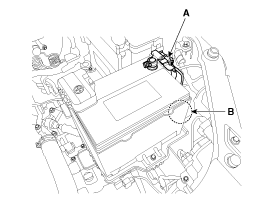Kia Cadenza: Charging System / Battery Sensor Repair procedures
Kia Cadenza YG 2016-2025 Service Manual / Engine Electrical System / Charging System / Battery Sensor Repair procedures
| Removal |
| 1. |
Turn the ignition switch OFF and disconnect the battery negative (-) cable. |
| 2. |
Disconnect the battery sensor connector (A). |
| 3. |
Remove the battery negative (-) cable after removing the bolt (B).
|
| Installation |
| 1. |
Install in the reverse order of removal.
|
| Adjustment |
Battery Sensor Recalibration Procedure
After reconnecting the battery negative cable, AMS function
does not operates until the system is stabilized, about 4 hours. If
disconnecting the negative (-) battery cable from the battery during
repair work for the vehicle equipped with AMS function, Battery sensor
recalibration procedure should be performed after finishing the repair
work.
| 1. |
Turn the Iginition switch ON and OFF. |
| 2. |
Park the vehicle for about 4 hours with the hood and all doors closed. |
 Battery Sensor Description and Operation
Battery Sensor Description and Operation
Description
Vehicles have many control units that use more electricity.
These units control their own system based on information from diverse
sensors. It is important to have a stable power s ...
 Starting System
Starting System
...
Other information:
Kia Cadenza YG 2016-2025 Service Manual: 35R Clutch Control Solenoid Valve(35R/C_VFS) Specifications
Specification Item SpecificationControl typeN/H (Normal High)Control pressure kpa (kgf/cm², psi)"500.14 ~ 9.81 (5.1 ~ 0.1, 72.54 ~ 1.42)"Current value (mA)50 ~ 850Coil resistance(Ω)5.1 ± 0.3 ...
Kia Cadenza YG 2016-2025 Owners Manual: All season tires. Summer tires. Snow tires
All season tires Kia specifies all season tires on some models to provide good performance for use all year round, including snowy and icy road conditions. All season tires are identified by ALL SEASON and/or M+S (Mud and Snow) on the tire sidewall. Snow tires have better snow tractio ...
Copyright © www.kcadenzavg.com 2017-2025



